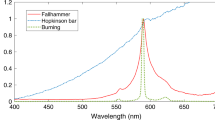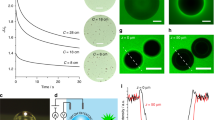Abstract
A RESULT of some interest has recently been obtained relative to the explosion of hydrogen and oxygen by the photosensitising action of chlorine in light from the mercury vapour lamp transmitted by glass. The experiments were initially carried out at a temperature of about 300° C. with the view of testing the possibility of the initiation of a hydrogen-oxygen chain mechanism by the hydrogen atoms produced in the hydrogen chloride synthesis. When 280 mm. of a mixture (2H2 + O2) was exposed in a cylindrical glass reaction vessel to light from a mercury lamp, no effect was observed. If chlorine in increasing quantities was added, a sharp limit of chlorine pressure was found, above which a practically instantaneous and quantitatively complete explosion of the hydrogen and oxygen to form water occurred. Below this limit a rapid reaction between the hydrogen and chlorine occurred, which was complete in a few minutes, only a trace of water formation, if any, being observable. The limit of chlorine pressure was exceedingly sharp and could be fixed with precision to one or two mm. In the particular apparatus used it was 135 mm. at 300° C. The experiments were then carried out at other temperatures, the quantity of hydrogen-oxygen mixture always being adjusted to a constant molar concentration in the reaction bulb. It was found, contrary to initial expectation, that the hydrogen-oxygen explosion could be sensitised down to room temperature, though a much greater chlorine pressure was required at this lower temperature. In the accompanying graph (Fig. 1) is plotted the limiting chlorine pressure, reduced to 0° C., required to sensitise the explosion of (2H2 + O2) at constant molar concentration corresponding to a total pressure of 156 mm. at 0° C.
This is a preview of subscription content, access via your institution
Access options
Subscribe to this journal
Receive 51 print issues and online access
$199.00 per year
only $3.90 per issue
Buy this article
- Purchase on Springer Link
- Instant access to full article PDF
Prices may be subject to local taxes which are calculated during checkout
Similar content being viewed by others
Author information
Authors and Affiliations
Rights and permissions
About this article
Cite this article
NORRISH, R. The Photosensitised Explosion of Hydrogen-Oxygen Mixtures in the Presence of Chlorine. Nature 127, 853–854 (1931). https://doi.org/10.1038/127853a0
Issue Date:
DOI: https://doi.org/10.1038/127853a0
Comments
By submitting a comment you agree to abide by our Terms and Community Guidelines. If you find something abusive or that does not comply with our terms or guidelines please flag it as inappropriate.



